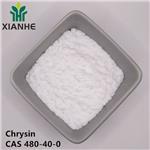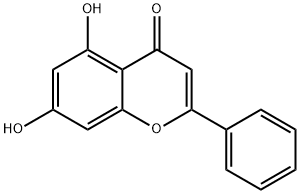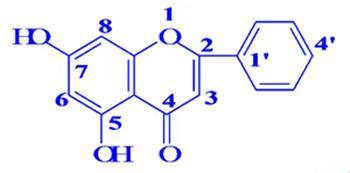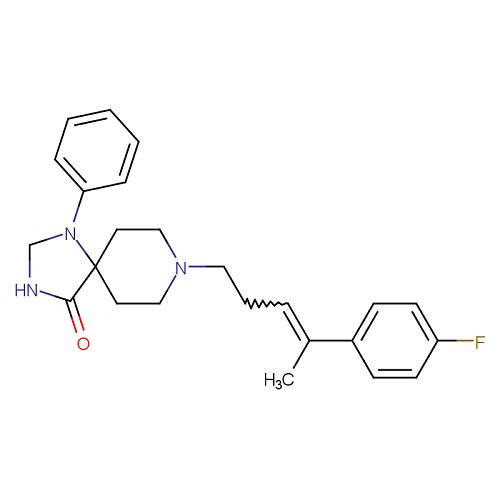Chrysin: Pharmacokinetics and Pharmacological Activities
General Description
Chrysin, a naturally occurring flavonoid, exhibits notable pharmacokinetic challenges due to its poor absorption and low bioavailability, particularly as it undergoes extensive metabolism via phase I and phase II reactions. Despite these limitations, chrysin demonstrates a broad range of pharmacological activities, including anticancer, anti-inflammatory, antioxidant, neuroprotective, antibacterial, and antidiabetic properties. It has shown potential as an aromatase inhibitor and as an agent for enhancing immune responses. While chrysin holds therapeutic promise, further research is needed to better understand its mechanisms of action and to develop methods for improving its bioavailability for clinical applications.

Figure 1. Chrysin
Pharmacokinetics
Chrysin, a naturally occurring flavonoid, features a complex structure consisting of two fused rings accompanied by a phenyl ring. Its pharmacokinetics is significantly influenced by its poor absorption, primarily observed in polyphenolic compounds like chrysin, especially when present as esters, glycosides, or polymers. Upon ingestion, chrysin undergoes hydrolysis by intestinal enzymes, leading to the formation of aglycones and various aromatic acids. These aglycones are notably potent but can limit the overall bioavailability of chrysin. The metabolism of chrysin occurs through phase I and phase II reactions, often involving conjugation processes like methylation, sulfation, and glucuronidation. Consequently, these metabolic processes contribute to the rapid elimination of chrysin from the body, resulting in low intrinsic activity. 1
Transportation and Bioavailability Challenges
Understanding the pharmacokinetics of chrysin also requires examining its efflux transport mechanisms. Key transporters involved in the handling of chrysin conjugates include the multidrug resistance-associated protein 2, the breast cancer resistance protein, and the ATP binding cassette family. MRP2 is particularly crucial as it facilitates the transport of chrysin metabolites across cellular membranes, predominantly in the liver and kidneys. Research has shown that chrysin conjugates are susceptible to hydrolysis by sulfatases and glucuronidases after transportation into the small intestine. Despite favorable membrane transport characteristics observed in studies using Caco-2 cells, chrysin's oral bioavailability remains alarmingly low at approximately 0.003–0.02%. Furthermore, the major barriers to effective absorption stem from the extensive metabolism of chrysin across various biological systems. Consequently, efforts to enhance the bioavailability of chrysin are ongoing, as researchers aim to overcome these significant pharmacokinetic challenges. 1
Pharmacological Activities
Overview
Chrysin, a naturally occurring flavonoid, has gained attention for its wide array of pharmacological activities, although its therapeutic benefits have been somewhat limited in literature due to challenges related to bioavailability and absorption. This compound has shown promising effects as a potent aromatase inhibitor as well as an agent that can activate the immune response in models of human immunodeficiency virus infection. Increasing evidence supports chrysin’s role as a pharmacological agent, demonstrating a range of bioactivities that include anti-inflammatory and antioxidant effects. Furthermore, chrysin has exhibited cancer chemopreventive properties through the induction of apoptosis in various human and animal cell types. The diverse pharmacological potential of chrysin includes anticancer, neuroprotective, antienteroviral, antibacterial, anti-inflammatory, anti-asthmatic, antidiabetic, antidepressant, and antiarthritic activities, which are worth exploring in detail. 2
Anticancer Activity
The anticancer activity of chrysin is particularly notable, as cancer remains a significant public health challenge globally. Research indicates that dietary phytochemicals, like chrysin, can play a protective role against cancer through mechanisms that include antioxidant and anti-inflammatory effects. Chrysin has been shown to improve antioxidant status while reducing lipid peroxidation, indicating its potential in maintaining redox homeostasis during the carcinogenesis process. Furthermore, mechanisms underlying the anticancer effects of chrysin involve the inhibition of tumor growth by promoting apoptosis and downregulating inflammation pathways. Notably, chrysin has been observed to activate the Notch1 signaling pathway, which is significant in the regulation of various cellular processes, including those relevant to cancer progression. Moreover, chrysin enhances the efficacy of conventional chemotherapy drugs, such as cisplatin, by stabilizing p53 gene expression and promoting cell death in HepG2 cancer cells. 2
Additional Therapeutic Potentials
Beyond its anticancer properties, chrysin exhibits potential therapeutic effects in several other areas. Its anti-inflammatory action suggests chrysin may help in managing conditions characterized by chronic inflammation, while its antioxidant properties may provide neuroprotective benefits. Furthermore, research has indicated that chrysin could have antidiabetic effects, potentially improving glucose metabolism or insulin sensitivity. Its antibacterial activity highlights the compound's promise in addressing various infections, while the anti-asthmatic and antidepressant effects point to chrysin's versatility in treating diverse health issues. Although much of the existing literature emphasizes the pharmacological potential of chrysin, further studies are essential to fully elucidate its mechanisms and enhance its bioavailability for therapeutic use. As researchers continue to explore the multifaceted role of chrysin, this compound may play a significant role in future pharmaceutical applications. 2
References:
[1] AWANISH MISHRA. Neuroprotective Potential of Chrysin: Mechanistic Insights and Therapeutic Potential for Neurological Disorders.[J]. ACS Applied Energy Materials, 2021. DOI:10.3390/molecules26216456.[2] RENUKA MANI V N. Chrysin: Sources, beneficial pharmacological activities, and molecular mechanism of action[J]. Phytochemistry, 2018, 145: 1-216. DOI:10.1016/j.phytochem.2017.09.016.
Related articles And Qustion
Lastest Price from Chrysin manufacturers

US $1.00-4.00/KG2025-09-08
- CAS:
- 480-40-0
- Min. Order:
- 1KG
- Purity:
- 99%
- Supply Ability:
- 200000KG

US $0.00/kg2025-04-29
- CAS:
- 480-40-0
- Min. Order:
- 1kg
- Purity:
- 0.99
- Supply Ability:
- 1000kg



